Evaluation of the Performance of Grouting Materials for Saturated Riprap
Abstract
:1. Introduction
2. Field Condition and Injection Test
2.1. Field Condition

2.2. Grout Mixture Ratio, Specimen and Tester
| Classification | OPC(kg) | Special OPC * (kg) | Lime (kg) | Sand (kg) | Antiwashout material (g) | Inflating agent (g) | Superplasticizer (g) | Water (kg) | |||
|---|---|---|---|---|---|---|---|---|---|---|---|
| No.4 | No.5 | No.6 | |||||||||
| General type | Low viscosity | 8.75 | – | 4 | 5 | 6 | 1.25 | 57.5 | 125 | 131.25 | 5.75 |
| High viscosity | 8.75 | – | 4 | 5 | 6 | 1.25 | 75 | 125 | 131.25 | 5.75 | |
| Quick-setting type | Low viscosity | 7.61 | 1.14 | 4 | 5 | 6 | 1.25 | 57.5 | 125 | 131.25 | 5.75 |
| High viscosity | 7.61 | 1.14 | 4 | 5 | 6 | 1.25 | 75 | 125 | 131.25 | 5.75 | |
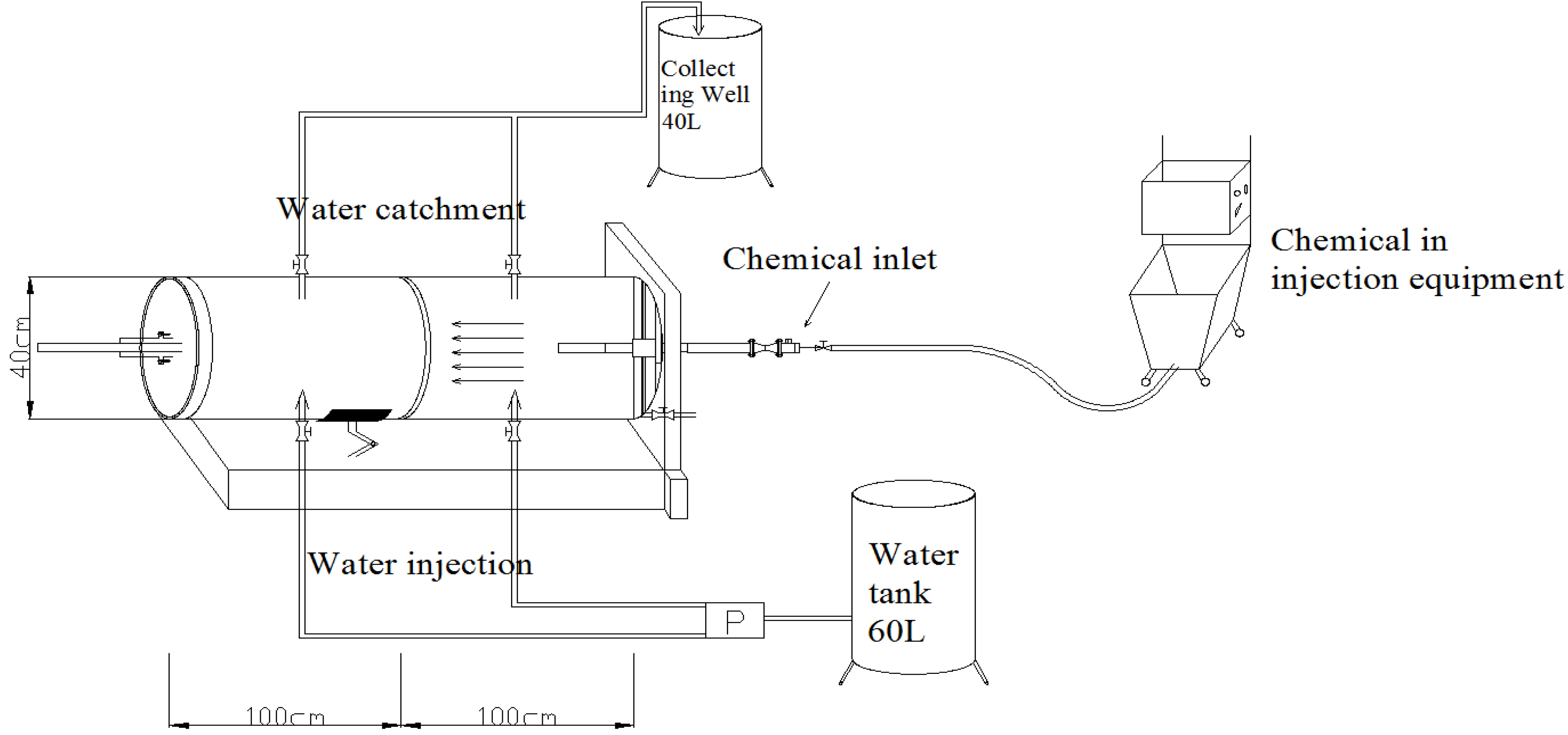

2.3. Method of Injection Test
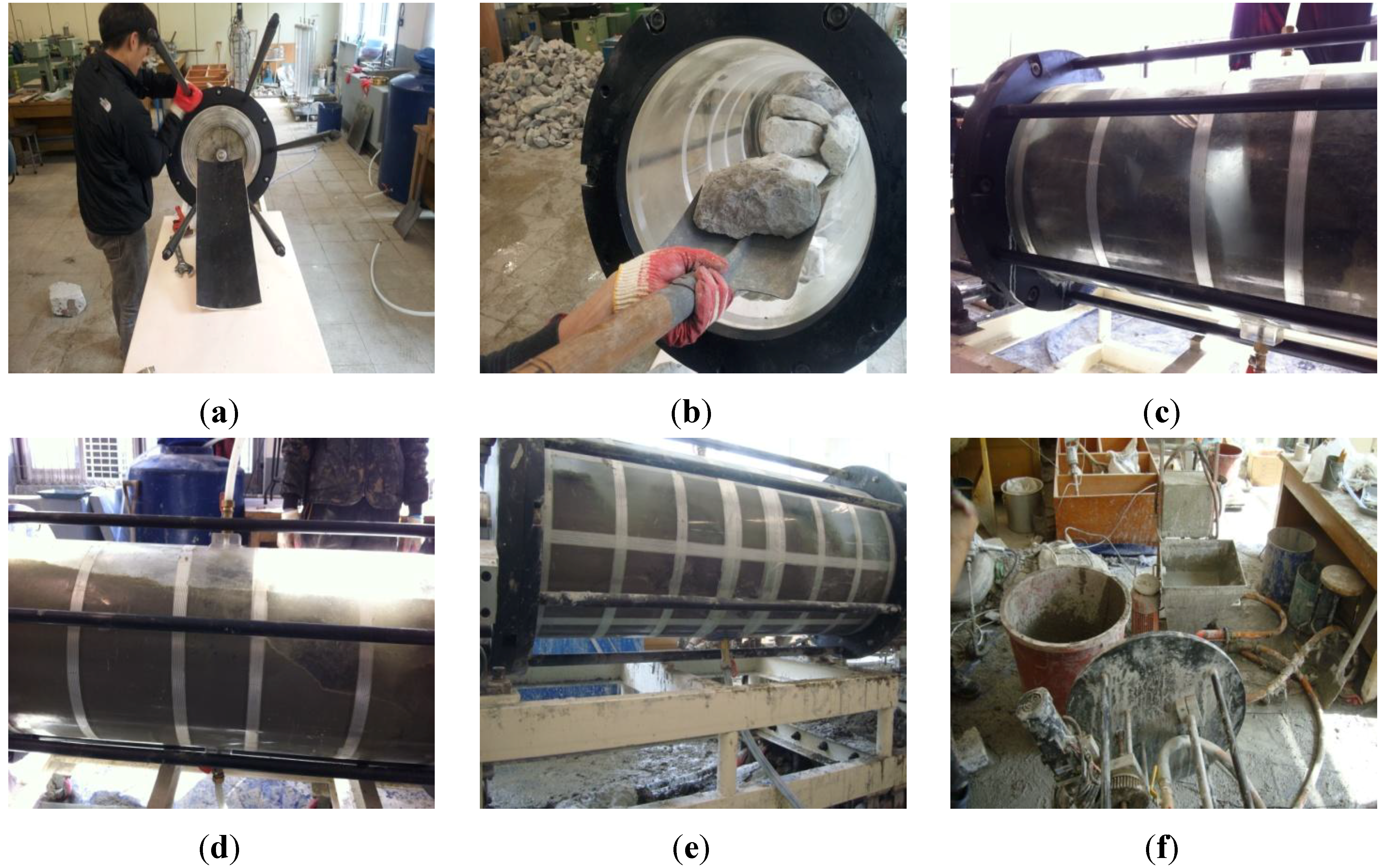
3. Results of Injection Test
3.1. Measuring Circumference of Injection and Formed Bulb


3.2. Results of Circumferential Measurement for Injected Material
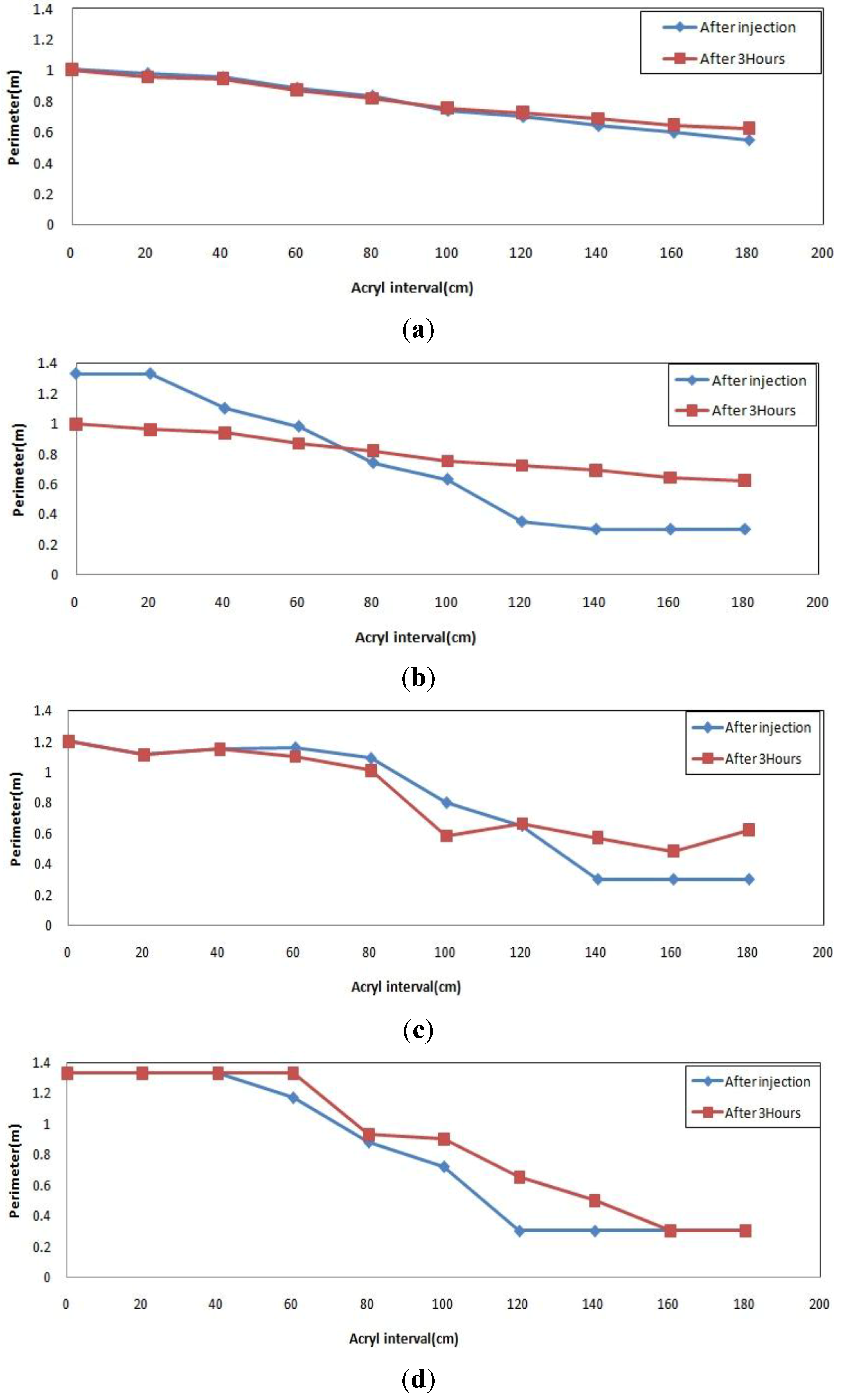
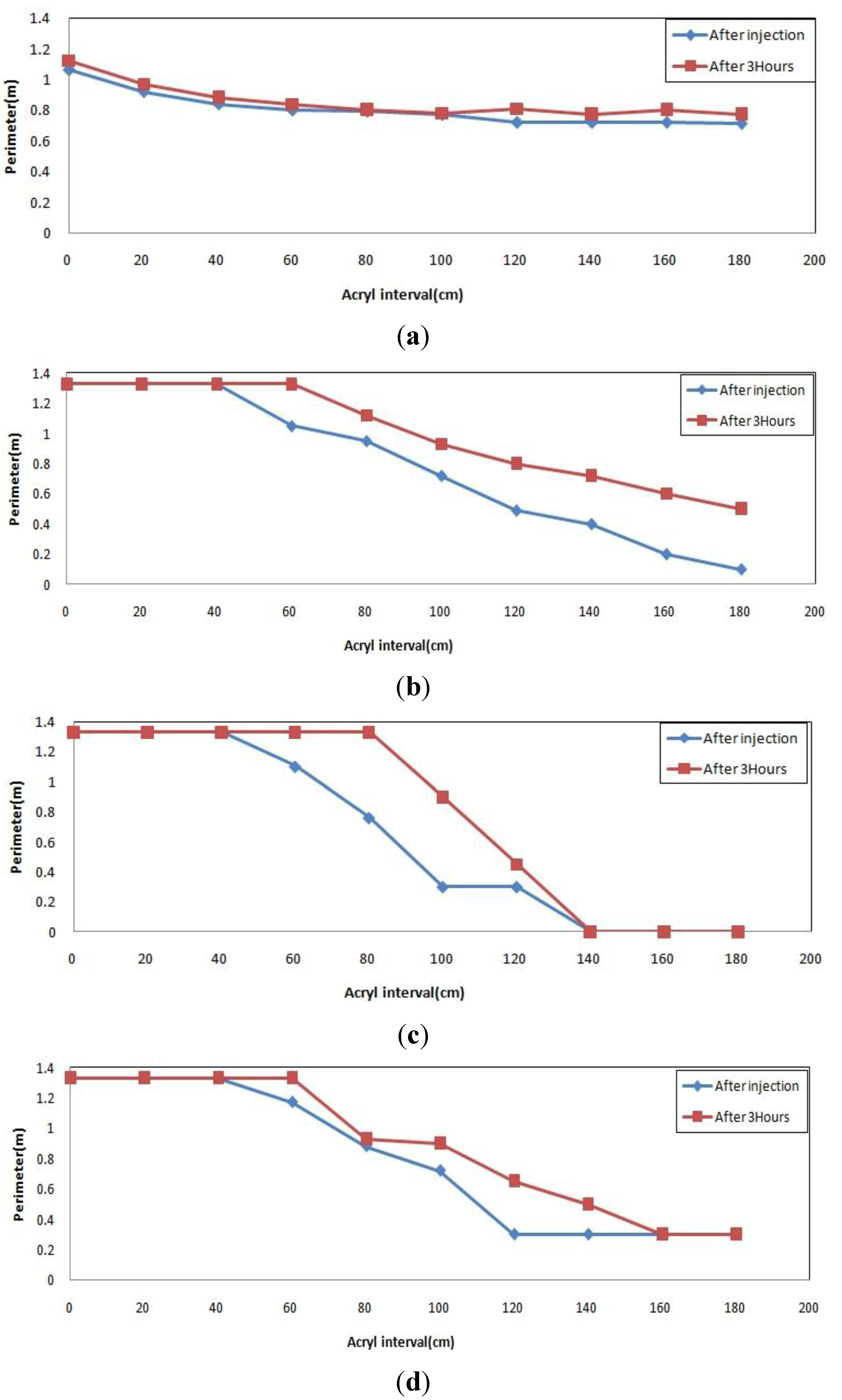
3.3. Results of Circumferential Measurement Depending on Flow
| Type | Materials | Injection speed (L/min) | Flow (cm/s) | Measurement time (h) | Interval for measuring circumference of injected material (m) | |||||||||
|---|---|---|---|---|---|---|---|---|---|---|---|---|---|---|
| 0 | 0.2 | 0.4 | 0.6 | 0.8 | 1.0 | 1.2 | 1.4 | 1.6 | 1.8 | |||||
| General Type | Low viscosity | 10 | 0 | After injection | 1.01 | 0.98 | 0.96 | 0.88 | 0.83 | 0.74 | 0.70 | 0.64 | 0.60 | 0.55 |
| After 3 h | 1.00 | 0.96 | 0.94 | 0.87 | 0.82 | 0.75 | 0.72 | 0.69 | 0.64 | 0.62 | ||||
| 100 | After injection | 1.33 | 1.33 | 1.1 | 0.98 | 0.74 | 0.63 | 0.35 | 0.3 | 0.3 | 0.3 | |||
| After 3 h | 0.88 | 0.86 | 0.84 | 0.81 | 0.75 | 0.7 | 0.68 | 0.65 | 0.65 | 0.65 | ||||
| High viscosity | 10 | 0 | After injection | 1.2 | 1.11 | 1.15 | 1.16 | 1.09 | 0.8 | 0.65 | 0.55 | 0.46 | 0.55 | |
| After 3 h | 1.2 | 1.11 | 1.15 | 1.10 | 1.01 | 0.81 | 0.66 | 0.57 | 0.48 | 0.62 | ||||
| 100 | After injection | 1.33 | 1.33 | 1.33 | 1.17 | 0.88 | 0.72 | 0.3 | 0 | 0 | 0 | |||
| After 3 h | 1.33 | 1.33 | 1.33 | 1.33 | 0.93 | 0.9 | 0.65 | 0.5 | 0.3 | 0.3 | ||||
| Type | Grout | Injection speed (L/min) | Flow condition (cm/s) | Measurement time (h) | Interval for measuring circumference of injected material (m) | |||||||||
|---|---|---|---|---|---|---|---|---|---|---|---|---|---|---|
| 0 | 0.2 | 0.4 | 0.6 | 0.8 | 1.0 | 1.2 | 1.4 | 1.6 | 1.8 | |||||
| Quick-setting Type | Low viscosity | 10 | 0 | After injection | 1.06 | 0.92 | 0.84 | 0.80 | 0.79 | 0.77 | 0.72 | 0.72 | 0.72 | 0.71 |
| After 3 h | 1.12 | 0.97 | 0.88 | 0.84 | 0.80 | 0.78 | 0.81 | 0.77 | 0.80 | 0.77 | ||||
| 100 | After injection | 0.95 | 0.95 | 0.93 | 0.75 | 0.73 | 0.68 | 0.63 | 0.54 | 0.5 | 0.3 | |||
| After 3 h | 1.13 | 1.09 | 0.99 | 0.88 | 0.88 | 0.82 | 0.78 | 0.7 | 0.7 | 0.6 | ||||
| High viscosity | 10 | 0 | After injection | 1.33 | 1.33 | 1.33 | 1.1 | 0.76 | 0.3 | 0.3 | 0 | 0 | 0 | |
| After 3 h | 1.33 | 1.33 | 1.33 | 1.33 | 1.33 | 0.9 | 0.45 | 0 | 0 | 0 | ||||
| 100 | After injection | 1.33 | 1.33 | 1.33 | 1.11 | 0.92 | 0.72 | 0.49 | 0.4 | 0.3 | 0.3 | |||
| After 3 h | 1.33 | 1.33 | 1.33 | 1.33 | 0.97 | 0.82 | 0.66 | 0.63 | 0.6 | 0.3 | ||||
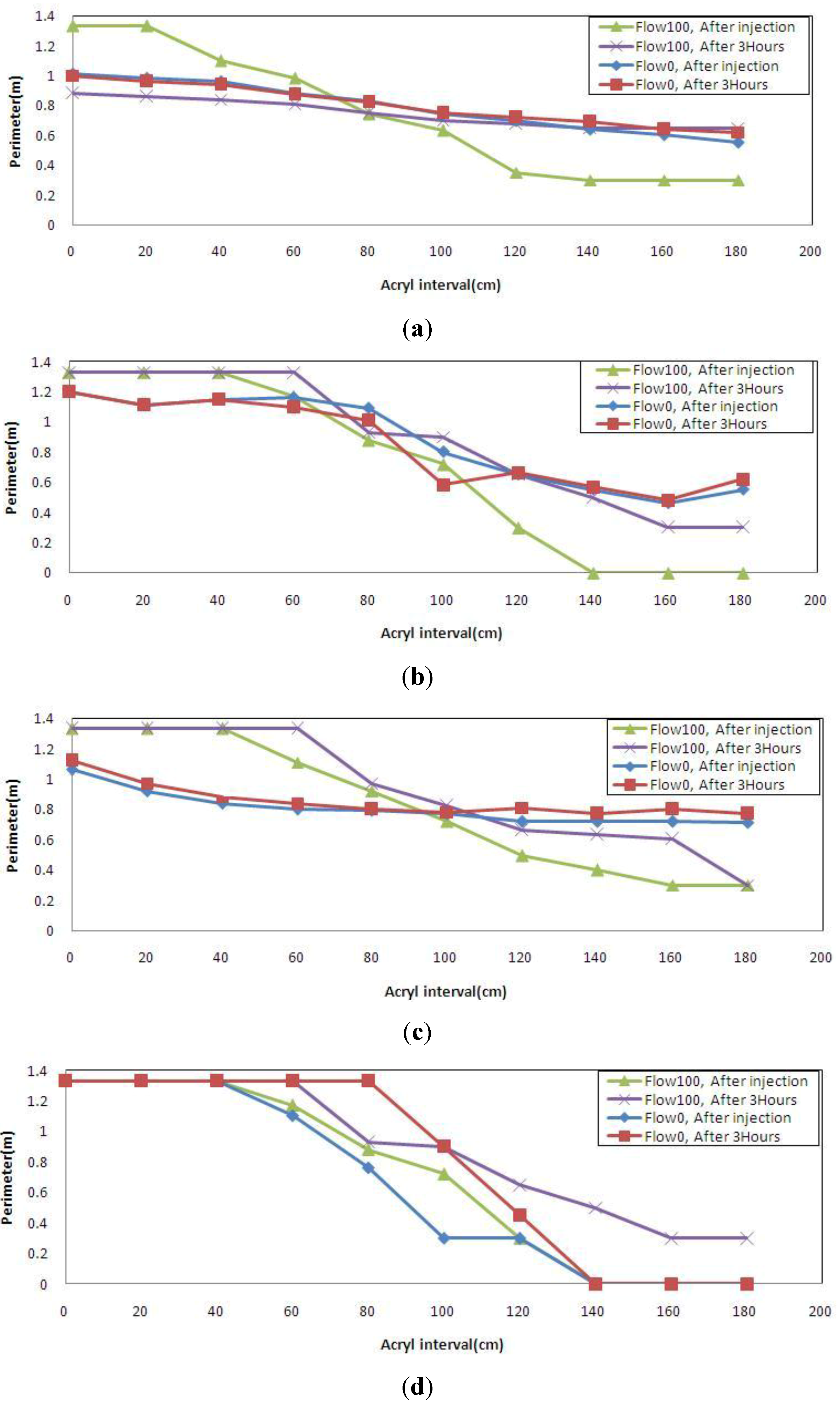
3.4. Analysis of Grout Expansibility
| Grout (Flow/Injection) | Measurement time (h) | Injection quantity | Expansibility (%) | Grout (Flow/Injection) | Measurement time (h) | Injection quantity | Expansibility (%) |
|---|---|---|---|---|---|---|---|
| General low viscosity type (0/10) | 0 | 137.9 | 1.92 | Quick-setting low viscosity type (0/10) | 0 | 141.2 | 5.80 |
| 3 | 140.6 | 3 | 149.9 | ||||
| General low viscosity type (100/10) | 0 | 120.6 | 8.64 | Quick-setting low viscosity type (100/10) | 0 | 120.2 | 19.44 |
| 3 | 132 | 3 | 149.2 | ||||
| General high viscosity type (0/10) | 0 | 138.1 | 5.75 | Quick-setting high viscosity type (0/10) | 0 | 102.4 | 23.24 |
| 3 | 146.5 | 3 | 133.4 | ||||
| General high viscosity type (100/10) | 0 | 132.6 | 12.42 | Quick-setting high viscosity type (100/10) | 0 | 131.4 | 24.13 |
| 3 | 151.4 | 3 | 173.2 |
3.5. Evaluation of Segregation
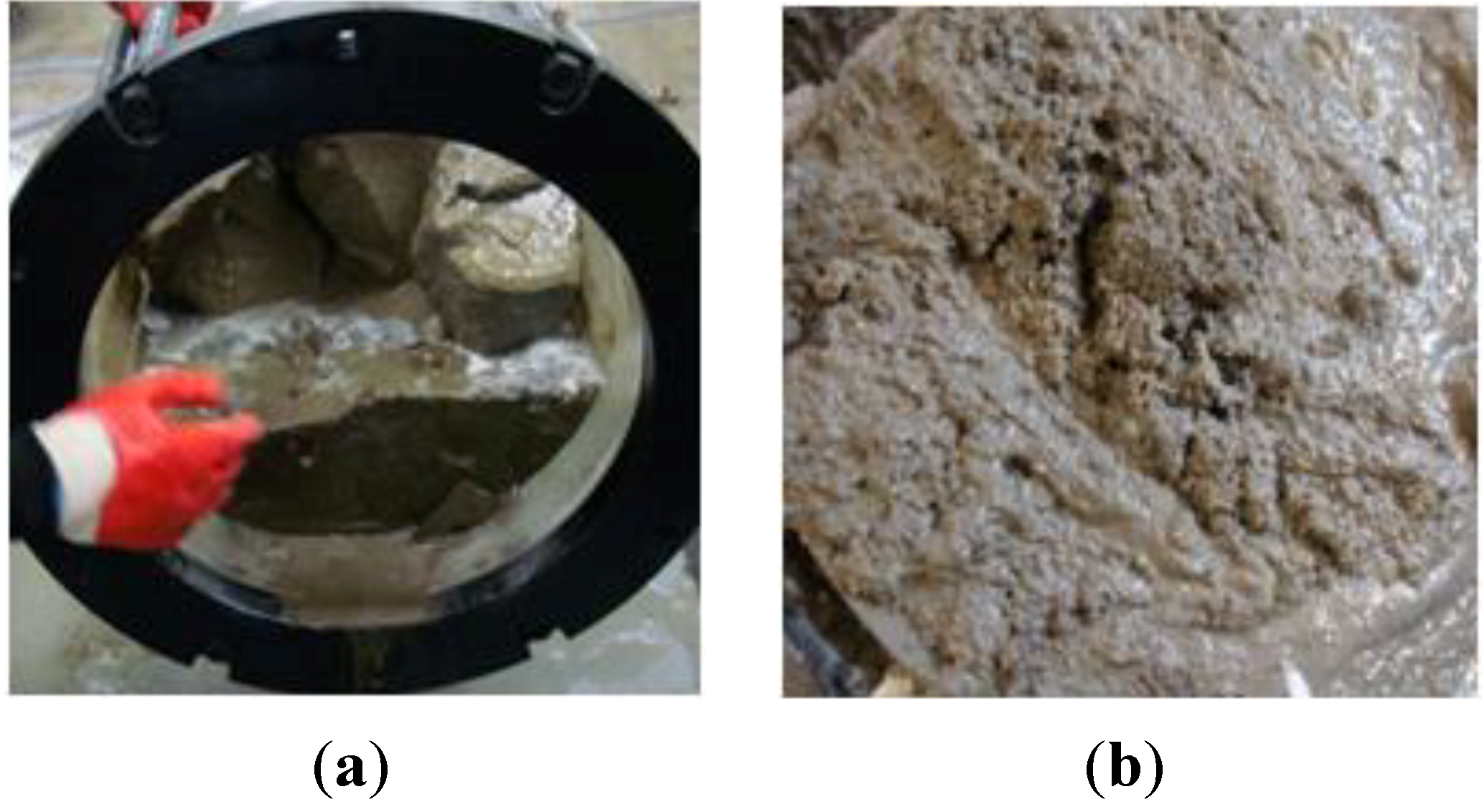
| Gravity material | Front | End | Deviation (%) |
|---|---|---|---|
| Mortar (Flow 0, Injection 10) | 2.161 | 3.104 | 30.38 |
| Cement (Flow 0, Injection 10) | 2.503 | 2.503 | 0 |
| General low viscosity (Flow 0, Injection 10) | 2.506 | 2.568 | 2.41 |
| General High viscosity (Flow 100, Injection 10) | 2.504 | 2.460 | 1.76 |
| Quick-setting low viscosity (Flow 100, Injection 10) | 2.506 | 2.612 | 4.06 |
| Quick-setting high viscosity (Flow 0, Injection 10) | 2.515 | 2.496 | 0.75 |
| Quick-setting high viscosity (Flow 100, Injection 10) | 2.343 | 2.398 | 2.29 |
4. Summary and Conclusions
- Examination of grout flow and expansibility over time revealed that the general low viscosity type grout exhibited high fluidity and slow setting and is thus ideal for areas with a wide injection range. The general high viscosity type grout exhibited low fluidity, but high expansibility, and is thus ideal for ground with great voids and no flow like riprap layers. The quick-setting low viscosity type and the high viscosity type also showed similar patterns to the general low viscosity type and the high viscosity type, but were analyzed as ideal for saturated riprap layers because of quick-setting.
- Evaluation of grout flowing and expansion patterns depending on flow (0 cm/s, 100 cm/s) revealed that the general low viscosity type was slightly affected by flow resulting in grout flowing, but was analyzed as not affected by flow in other tests.
- Assessment of grout expansibility revealed that the highest expansibility of the general high viscosity type for flow 100/injection speed 10 was 12.42% and the highest expansibility of the quick-setting high viscosity type for flow 100/injection speed 10 was 24.13%. An analysis revealed that high viscosity grout had higher expansibility than low viscosity grout, and the expansibility of the quick-setting type was twice as high as the general type.
- Evaluation of no segregation of developed grout through the specific gravity test revealed a material segregation 2.161 for the front and 3.104 for the end of the conventional injection material mortar. However, the developed material used in this study had a slight deviation not to cause material segregation and is thus an ideal grout for riprap layers with great voids.
- The expansibility of the quick-setting high viscosity was large enough to fill the gaps between the ripraps, and the washout of the grout in the ripraps with ground water flow was negligible. This clearly indicates that the quick-setting high viscosity type showed a satisfactory performance in the grouting of the saturated riprap layer with water flow.
Acknowledgments
Conflicts of Interest
References
- Kim, J.C. A study on Injection Characteristics of Cement. Ph.D. Thesis, Hanyang University, Seoul, Korea, 1 August 1999. [Google Scholar]
- Yu, H.K.; Bu, S.A.; Han, S.J.; Kim, S.S. Optimum Mixing Design. In Proceedings of KSCE Conference, Daejun Convention Center, Daejun, Korea, 28–31 October 2008.
- Maeng, S.S. Particle Limit on the Grouting of Embankment. MSCE Thesis, Seoul City University, Seoul, Korea, 1 August 2009. [Google Scholar]
- Kim, H.Y. A Study on Characteristics of Silica-Cement. Ph.D. Thesis, Hanyang University, Seoul, Korea, 1 August 1999. [Google Scholar]
- Lee, H.W. Infiltration Characteristics for Embankment. Ph.D. Thesis, Seoul National University, Seoul, Korea, 1 February 2005. [Google Scholar]
- Yang, P.; Peng, Z.B.; Tang, Y.Q.; Peng, W.X.; He, Z.M. Penetration grouting reinforcement of sandy gravel. J. Cent. South Univ. Technol. 2008, 15, 280–284. [Google Scholar]
- Girard, L.G.; Clopper, P.E. Integration European partially grouted riprap for stream stability and bridge scour protection. Available online: http://www.ieca.org/membersonly/cms/content/Proceedings/Object338PDFEnglish.pdf (accessed on 5 December 2013).
© 2013 by the authors; licensee MDPI, Basel, Switzerland. This article is an open access article distributed under the terms and conditions of the Creative Commons Attribution license (http://creativecommons.org/licenses/by/3.0/).
Share and Cite
Kim, D.; Jung, S.; Cha, K. Evaluation of the Performance of Grouting Materials for Saturated Riprap. Materials 2013, 6, 5713-5725. https://doi.org/10.3390/ma6125713
Kim D, Jung S, Cha K. Evaluation of the Performance of Grouting Materials for Saturated Riprap. Materials. 2013; 6(12):5713-5725. https://doi.org/10.3390/ma6125713
Chicago/Turabian StyleKim, Daehyeon, Sinkyu Jung, and Kyungsub Cha. 2013. "Evaluation of the Performance of Grouting Materials for Saturated Riprap" Materials 6, no. 12: 5713-5725. https://doi.org/10.3390/ma6125713




